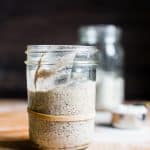
Gluten Free Sourdough Starter
*The blog post above has more tips and information!* Making a gluten free sourdough starter couldn't be easier. Start with a few simple ingredients, a little time and patience, soon you'll be making delicious homemade gluten free sourdough bread, pancakes, and waffles! This recipe is gluten free and vegan. This process generally takes between 6-7 days to complete, with only minutes each day to prepare it. Be aware that it could take longer. This is the nature of sourdough.
Ingredients
- Buckwheat Flour or Brown Rice Flour
- Sweet White Rice Flour or AP 1-1 gluten free baking flour
- Water room temperature **see note
Instructions
- Day One: In a medium glass bowl or jar, whisk together 2 T (20g) buckwheat or brown rice flour, 2 T (20g) sweet rice flour and 1/4 C (60g) of water. Cover with a damp tea towel and rest at room temperature for 24 hours.
- Day Two: In a clean medium glass bowl or jar, whisk 2 T (40g) of mixture you made yesterday (throw out the leftovers), 2 T (20g) buckwheat or brown rice flour, 2 T (20g) sweet rice flour and 1/4 C (60g) of water. Cover with a damp towel or loose fitting lid and rest at room temperature for 24 hours.
- Day Three Through Day Six or Seven (or beyond): Repeat step two using the previous days starter until the mixture becomes puffy, has a pleasant sweet-sour aroma and bubbles begin or air pockets are visible under the surface. This process takes about six to seven days (as this has been my experience) - but it may take longer. Time is not a determining factor for when the starter is ready, it's simply a guide. It's ready when it's ready. Use the cues and your senses to determine when your starter is ready. This is the nature of sourdough. Before using your new starter in a recipe, you'll need to refresh (feed) it.
How to Refresh your Gluten Free Sourdough Starter:
- Once you have an established starter, you'll need to feed it.In a clean lidded jar, add 1/4C (60g) of sourdough starter (throw out or save the leftover 'discard'). To the starter, mix in 1/3 C (80g) room temperature water. Add 3 T (30g) buckwheat flour and 3 T (30g) sweet white rice flour to the water mixture. Mix well until the flours are hydrated. Wrap a rubber band around the jar at the height of the starter. This will give you a visual indication of how much the starter has grown. Put a lid on the jar (it doesn't need to be loose - just regular) and allow the starter to develop at room temperature for about 8-12 hours* or until it doubles in size. The time will vary due to ambient temperature.If your starter is struggling to double, place it somewhere warm, like inside a turned off oven with a light on. You can also try feeding twice a day to nudge the starter along.Once the starter has doubled in size, is bubbly, and has a sweet-sour aroma, it's ready to use in your gluten free sourdough bread recipe.After measuring out the portion needed for your recipe, refresh the starter, as indicated above and store it until ready to use again.
How to Store Your Starter:
- Room Temperature: The starter can be stored at room temperature if you bake daily, which also means it will be need to be refreshed daily. Store it in a glass jar with a lid. Refrigerator: Ideally, you'll want to refresh your starter (feed it) each week if stored in the refrigerator. When preparing for mixing, and after pulling the starter from the fridge, you may need to refresh it twice within a 12 hour period to get it going again. This is not always the case, but sometimes the starter can be sluggish. Store it in a glass jar with a lid. Freezer: For longer storage, place your starter in the freezer. It will revive after it thaws in the refrigerator and goes through a few refreshments. Store it in a glass jar with a lid.
How to Store Your Discard if Saving:
- Once you have an established starter, you can use it for bread, and your discard for pancakes, waffles, pizza and other recipes to add that tangy sourdough flavor. Store it in the fridge, in a lidded glass jar, for up to two weeks. You may see a layer of hooch, and this is not unusual. You can pour it off or stir it in. If you see any white, orange or pink film or mold, toss it. You can also store your discard in the freezer for longer storage. Thaw it in the fridge before using in a recipe.
Notes
Sourdough discard? Save it, put it in a covered container in the refrigerator and then, make Gluten Free Sourdough Pizza Crust, Sourdough Waffles and Gluten Free Sourdough Pancakes!
*If you're in a hurry and have an established starter, you can increase the speed at which the starter doubles in size simply by heating the water to 80F before refreshing the starter. When I do this, my starter typically doubles in size in about four hours.
**Filtered vs Tap Water: I've tried both and haven't experienced a noticeable difference in activity in my starter or bread. Chlorine and hard water can be a problem for your starter and bread development, however, and tap water quality varies widely. So, if in doubt, use filtered water.